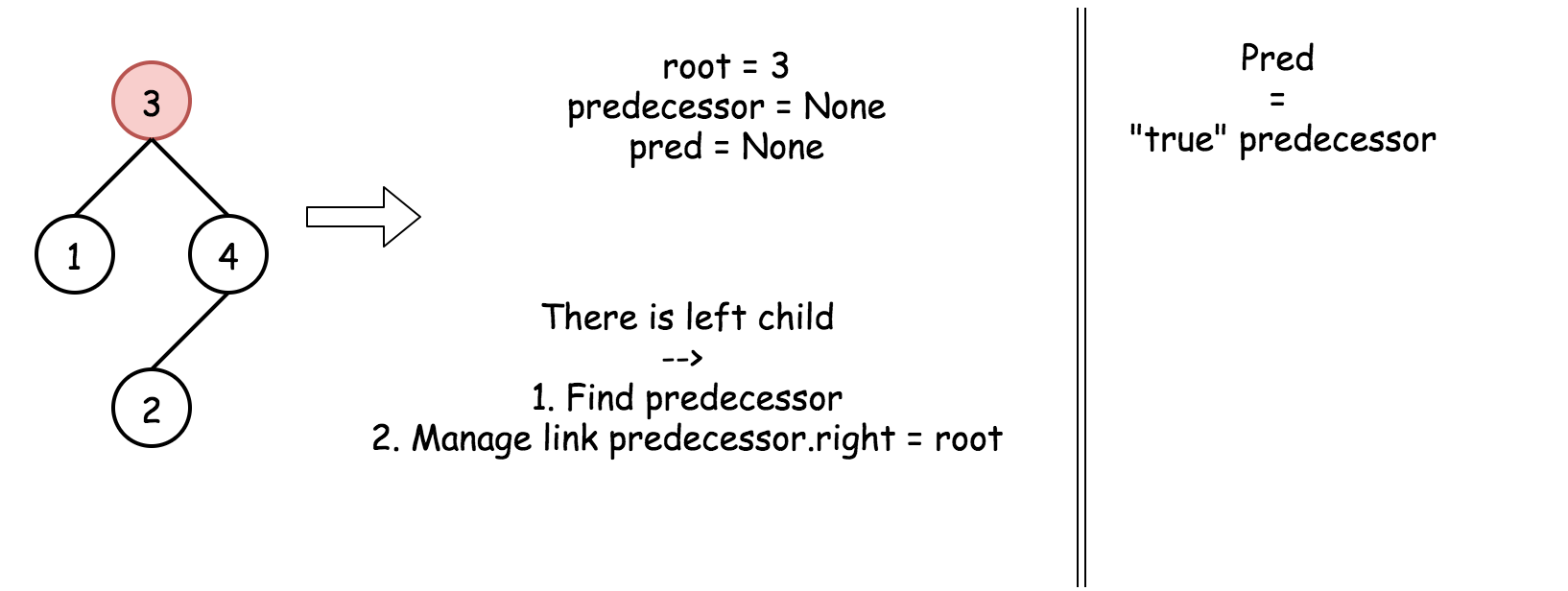题目0099:恢复二叉搜索树
题目描述
二叉搜索树中的两个节点被错误地交换。
请在不改变其结构的情况下,恢复这棵树。
示例1:
输入: [1,3,null,null,2]
1
/
3
\
2
输出: [3,1,null,null,2]
3
/
1
\
2
示例2:
输入: [3,1,4,null,null,2]
3
/ \
1 4
/
2
输出: [2,1,4,null,null,3]
2
/ \
1 4
/
3
进阶:
使用O(n)空间复杂度的解法很容易实现。
你能想出一个只使用常数空间的解决方案吗?
解题技巧
- 方法一:对数组进行排序
让我们从直截了当但却不是最优的解决方案开始。这个解决方案具有线性的时间和空间复杂性。
我们直到BST的中序遍历是升序序列。下面展示了如何计算中序遍历。
# Definition for a binary tree node.
# class TreeNode(object):
# def __init__(self, val=0, left=None, right=None):
# self.val = val
# self.left = left
# self.right = right
def inorder(r: TreeNode) -> List[int]:
return inorder(r.left) + [r.val] + inorder(r.right) if r else []
这里被交换了两个节点,因此中序遍历是一个几乎排好序的数组,其中有两个元素被交换。识别排序数组中两个交换元素是可以在线性时间内解决的经典问题。
def find_two_swapped(nums: List[int]) -> (int, int):
n = len(nums)
x = y = -1
for i in range(n - 1):
if nums[i + 1] < nums[i]:
y = nums[i + 1]
# first swap occurence
if x == -1:
x = nums[i]
# second swap occurence
else:
break
return x, y
当已知两个交换节点,再次遍历树,交换该节点的值。
算法:
按中序遍历树。遍历后的数组应该是几乎排序的列表,其中只有两个元素被交换。
在线性时间内确定几乎排序数组中的两个交换元素x和y。
再次遍历树,将值x的节点改为y,将值y的节点改为x。
class Solution:
def recoverTree(self, root: TreeNode):
"""
:rtype: void Do not return anything, modify root in-place instead.
"""
def inorder(r: TreeNode) -> List[int]:
return inorder(r.left) + [r.val] + inorder(r.right) if r else []
def find_two_swapped(nums: List[int]) -> (int, int):
n = len(nums)
x = y = -1
for i in range(n - 1):
if nums[i + 1] < nums[i]:
y = nums[i + 1]
# first swap occurence
if x == -1:
x = nums[i]
# second swap occurence
else:
break
return x, y
def recover(r: TreeNode, count: int):
if r:
if r.val == x or r.val == y:
r.val = y if r.val == x else x
count -= 1
if count == 0:
return
recover(r.left, count)
recover(r.right, count)
nums = inorder(root)
x, y = find_two_swapped(nums)
recover(root, 2)
复杂度分析
时间复杂度:\mathcal{O}(N)。中序遍历需要\mathcal{O}(N)的时间,判断两个交换节点:在最好的情况下是\mathcal{O}(1),在最坏的情况下是\mathcal{O}(N)。
空间复杂度:\mathcal{O}(N),我们用nums数组保存了树的中序遍历列表。
- 方法二:迭代中序遍历
算法:
在这里,我们通过迭代构造中序遍历,并在一次遍历中找到交换的节点。
迭代顺序很简单:尽可能的向左走,然后向右走一步,重复一直到结束。
若要找到交换的节点,就记录中序遍历中的最后一个节点pred(即当前节点的前置节点),并与当前节点的值进行比较。如果当前节点的值小于前置节点pred的值,说明该节点是交换节点之一。
交换的节点只有两个,因此在确定了第二个交换节点以后,可以终止遍历。
这样,就可以直接获取节点(而不仅仅是它们的值),从而实现\mathcal{O}(1)的交换时间,大大减少了步骤3所需的时间。

在java中用ArrayDeque代替栈。
class Solution:
def recoverTree(self, root: TreeNode):
"""
:rtype: void Do not return anything, modify root in-place instead.
"""
stack = []
x = y = pred = None
while stack or root:
while root:
stack.append(root)
root = root.left
root = stack.pop()
if pred and root.val < pred.val:
y = root
if x is None:
x = pred
else:
break
pred = root
root = root.right
x.val, y.val = y.val, x.val
复杂度分析
时间复杂度:最好的情况下是\mathcal{O}(1);最坏的情况下是交换节点之一是最右边的叶节点时,此时是\mathcal{O}(N)。
空间复杂度:最大是\mathcal{O}(H)来维持栈的大小,其中H指的是树的高度。
- 方法三:递归中序遍历
算法:
方法二的迭代可以转换为递归方式。
递归中序遍历很简单:遵循Left->Node->Right方向,即对左子节点进行递归调用,然后判断该节点是否被交换,然后对右子节点执行递归调用。
class Solution:
def recoverTree(self, root):
"""
:type root: TreeNode
:rtype: void Do not return anything, modify root in-place instead.
"""
def find_two_swapped(root: TreeNode):
nonlocal x, y, pred
if root is None:
return
find_two_swapped(root.left)
if pred and root.val < pred.val:
y = root
# first swap occurence
if x is None:
x = pred
# second swap occurence
else:
return
pred = root
find_two_swapped(root.right)
x = y = pred = None
find_two_swapped(root)
x.val, y.val = y.val, x.val
复杂度分析
时间复杂度:最好的情况下是\mathcal{O}(1);最坏的情况下是交换节点之一是最右边的叶节点时,此时是\mathcal{O}(N)。 空间复杂度:最大是\mathcal{O}(H)来维持递归调用堆栈的大小,其中H指的是树的高度。
- 方法四:Morris中序遍历
算法:
我们已经讨论了迭代和递归中序遍历,但是这两种遍历尽管使用了\mathcal{O}(H)的空间去存储栈空间,但是都有较大的时间复杂度。我们可以通过牺牲性能来届生空间。
Morris的遍历思想很简单:只遍历树而不是用空间。
怎么能够做到呢?在每个节点上,你必须决定下一个遍历的方向:遍历左子树或者右子树。如果不适用额外的空间,怎么指的左子树已经遍历完成了呢?
Morris算法的思想是在节点和它的直接前驱之间设置一个临时的链接:predecessor.right=root,从该节点开始,找到它的直接前驱并验证是否存在链接。
如果没有链接,设置连接并走向左子树。
如果有连接,断开连接并走向右子树。
这里有一个小问题要处理:如果该节点没有左孩子,即没有左子树,则我们直接走向右子树。

class Solution:
def recoverTree(self, root):
"""
:type root: TreeNode
:rtype: void Do not return anything, modify root in-place instead.
"""
# predecessor is a Morris predecessor.
# In the 'loop' cases it could be equal to the node itself predecessor == root.
# pred is a 'true' predecessor,
# the previous node in the inorder traversal.
x = y = predecessor = pred = None
while root:
# If there is a left child
# then compute the predecessor.
# If there is no link predecessor.right = root --> set it.
# If there is a link predecessor.right = root --> break it.
if root.left:
# Predecessor node is one step left
# and then right till you can.
predecessor = root.left
while predecessor.right and predecessor.right != root:
predecessor = predecessor.right
# set link predecessor.right = root
# and go to explore left subtree
if predecessor.right is None:
predecessor.right = root
root = root.left
# break link predecessor.right = root
# link is broken : time to change subtree and go right
else:
# check for the swapped nodes
if pred and root.val < pred.val:
y = root
if x is None:
x = pred
pred = root
predecessor.right = None
root = root.right
# If there is no left child
# then just go right.
else:
# check for the swapped nodes
if pred and root.val < pred.val:
y = root
if x is None:
x = pred
pred = root
root = root.right
x.val, y.val = y.val, x.val
复杂度分析:
时间复杂度:\mathcal{O}(N),我们访问每个节点两次。
空间复杂度:\mathcal{O}(1)。